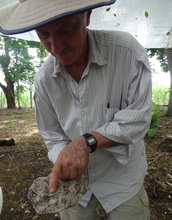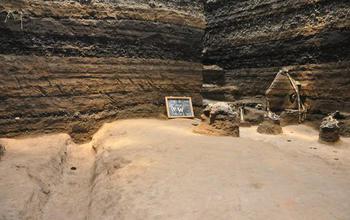All Images
News Release 15-140
Buried in ash, ancient Salvadoran village shows images of daily life
Village of Ceren so well preserved that footprints and finger marks remain
This material is available primarily for archival purposes. Telephone numbers or other contact information may be out of date; please see current contact information at media contacts.

Structures at Ceren were buried in up to 17 feet of ash over a period of several days, freezing the 1,400-year-old village in time.
Credit: University of Colorado
Download the high-resolution JPG version of the image. (2.2 MB)
Use your mouse to right-click (Mac users may need to Ctrl-click) the link above and choose the option that will save the file or target to your computer.

Professor Payson Sheets points to the imprint of several toes from a footprint left on the Ceren sacbe. Footprints pointed away from the village and may have been made by Mayans fleeing the volcanic eruption.
Credit: Rachel Egan, University of Colorado
Download the high-resolution JPG version of the image. (4.1 MB)
Use your mouse to right-click (Mac users may need to Ctrl-click) the link above and choose the option that will save the file or target to your computer.

A view of the Ceren sacbe buried under about 16 feet of ash. The trench on the left side was a drainage canal to catch excess rainwater.
Credit: University of Colorado
Download the high-resolution JPG version of the image. (225.2 KB)
Use your mouse to right-click (Mac users may need to Ctrl-click) the link above and choose the option that will save the file or target to your computer.
